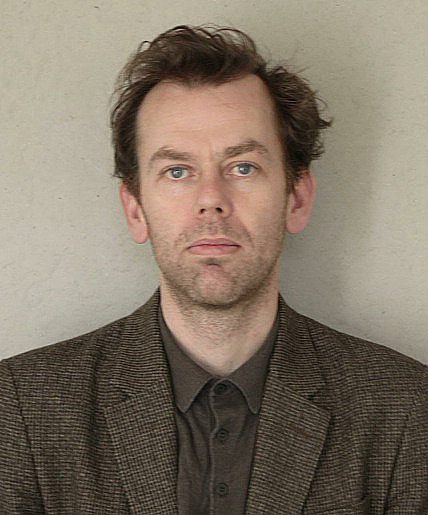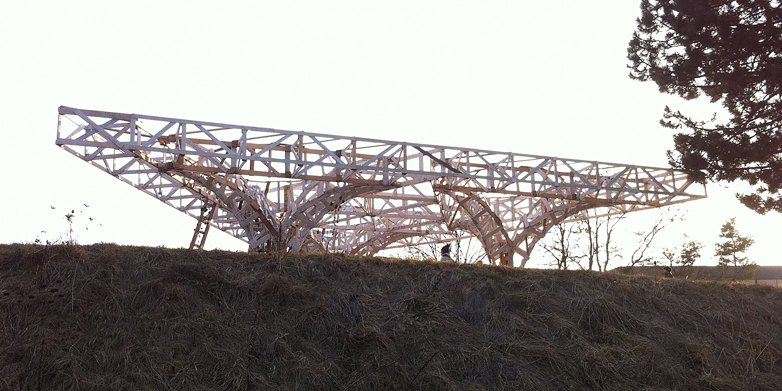Clear the stage for architecture
gta exhibitions is opening the new season with various projects. One of them is “Atlas”, a project by Tom Emerson, professor of architecture and construction.
In recent semesters, the students working at Studio Tom Emerson have created several collaborative structures re-using materials and surveys of post-industrial cities. "Atlas" is an exhibition of these works as well as a new project built by students. ETH News talked to Tom Emerson about his motivation and his experiences working with students.

Professor Emerson, what’s the main intention of your Atlas project?
Atlas is a general title for a way of working in which we try to integrate aspects of architecture that have been separated over the past century of Modernism. We try to merge scales – from making by hand to territorial studies, merge the digital technologies with traditions and most importantly to try to evolve a new relationship to nature, to place ourselves within it, rather than simply look at it.
For the fall programme of gta exhibitions your students will design and make a stage – quite unusual for students of architecture…
The Stage, or more precisely Stages, forms part of a new exhibitions programme initiated by Niels Olsen and Fredi Fischli of the gta, that takes the presentation of architecture beyond the gallery and beyond professional boundaries – right into the heart of the department. To make the Stage with second-year students is a nice way to make the exhibition belong to all the students.
And what will happen on the Stage?
The Stage could be seen as the four structures built by the students, or it could be more generally the department of architecture at ETH. In either case, the Stage is where our discipline gets played out every day: in the studios, lecture theatres, research spaces, workshops and coffee bars, and then also in more temporary events like exhibitions, talks and seminars. The curators have planned a programme of events, but a week before it opens people are already asking if they can use the stages for their own events. We hope that people will also use them spontaneously for lunch and meeting people on the roof, that they become part of the social equipment of our department.
What are you doing with the Stage after the exhibition?
After these exhibitions, the Stage will be reused for further exhibitions. It may be added to, some of it may be removed and simply adapted. We do not know exactly, but the idea is that exhibitions are not discrete entities that arrive and leave without leaving traces – they are part of a continuity.
“Atlas” is also an overview of the collective student works from your Studio – do you have any particular favorites among them? And if so, why?
That’s an unfair question; I like them all for different reasons. And there is much more work which is not shown here that I like too, but that we couldn’t fit. Maybe “96 Hands” stands out because it was the first project. We had no idea how it would turn out or how the students would work with one another. It was a high-risk start, but the students were brilliant and gave us a lot of confidence in doing more ambitious work.
Your students are always directly involved in your projects – what has your experience been with that way of working?
It is always difficult working with a large group of people – between 40 and 60. Lots of intelligence and creativity, but also competition and rivalries. The trick is to find a way of making all those qualities work towards a bigger whole. Sometimes sparks fly a little as individuals feel frustrated that they are not being listened to or feel they have a better idea than the group, but it never fails to amaze me what people are capable of doing when working together. They can overcome the most challenging conceptual and creative problems while also resolving the small practicalities that can get in the way. They learn from one another and support each other. Lessons are taught and learnt which could never happen in a conventional teaching environment. When it works, they are very inspirational.
You focus on “re-use” at various levels. For most people, architecture means building new things. What fascinates you about the idea of re-using?
I think this is a fundamental question for our times. The idea that architecture stands for new buildings while re-use is minor activity besides is quite out of date. In fact, in the work presented in the exhibition, I would argue that re-use is our new and only reality. The idea that architecture can be created independently from other things, from history, place and culture, is part of the hubris of Modernism now a century old. It is a way of thinking which has caused the deeply damaging separation between nature and culture. In order for us to respond to urgencies of the contemporary world (a more responsible use and distribution of natural and economic resources), we need to acknowledge first of all that we are part of nature, we are natural. Every piece of land has been occupied in some way before, whether by agriculture or urban settlements. To claim to be making something new is to deny that fundamental relationship to what already exists.
And what’s your favorite re-used “material”?
Maybe the weather. It is certainly the one we have ignored the most.
About
Tom Emerson was born in 1970 in France and studied at the University of Bath, the Royal College of Art in London and the University of Cambridge. Studio Tom Emerson is a design and research chair in the Department of Architecture at ETH Zurich. Set up in 2010, the studio focuses on re-use and bricolage in architecture and the narrative of history.
gta exhibitions - the fall 2014 programme
This fall, Studio Tom Emerson will build a series of stages within the ETH Zurich architecture department as a way to re-see the public spaces of the school. These structures will host an ongoing programme of exhibitions and events.
ETH Zurich, Hönggerberg, HIL, gta exhibitions
Opening hours: Mon–Fri, 10 am – 6 pm; closed on Sat/Sun and public holidays
Guided student tours: 12:30 pm daily
For updates about the opening


Comments
No comments yet